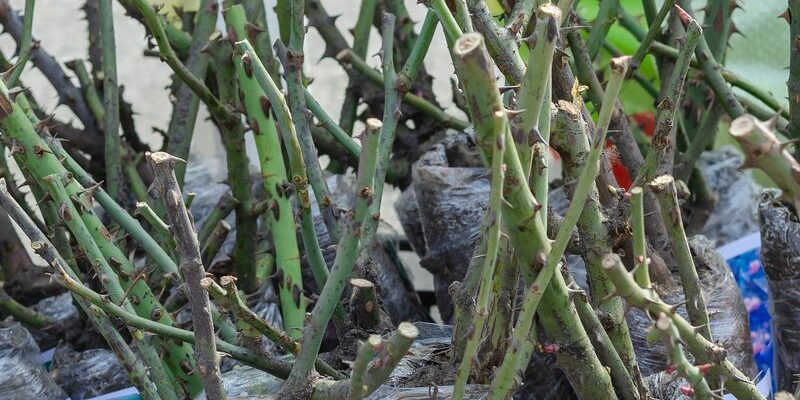Handling and Planting “Bare Root” Plants in the Home Landscape
Chances are good that you’ve bought or ordered bare root plants before — those plants that come with no soil around their roots. Lots of plants are sold as bare root plants, including some roses, ornamental trees and shrubs, fruit trees, asparagus, and some perennials. Need some tips on what to do with them once you get them home? Here’s some time-tested advice:
Not ready to plant yet? If the moss or other packing material is just barely damp, go ahead and add a bit of water, then wrap it up again. Keep them in a cool, dark place until you’re ready to plant, but don’t wait more than a few days.
Ready to plant? Remove the packing material and inspect the plant for signs of damage, and trim off any broken branches or roots.
Soak ‘em! Place the root part of your plant in tepid water to get them off to a good start. Aim for 1 one or 2 hours for woody plants.
Dig a hole. Dig it wide and deep enough so that the roots can fit in without bending or crowding. Don’t trim your roots to fit the hole!
Plant and water. Place the plant in the hole at the same level it was grown at the nursery and gently fill in and surround it with soil. Lightly pack it in to get rid of any air pockets. Your plant’s roots should be in the soil with the upper branches above the soil, making sure the added soil is at the same level as the surrounding ground. Water well after planting.
How to choose and get the best results from ‘bare root’ trees, shrubs, and other perennials.
What are “bare root” plants?
Bare root plants are dormant (not actively growing) perennial plants that are dug up and stored without any soil around their roots. Usually these plants are dug when they’re dormant and then refrigerated until it is time to ship them to you. This system can work really well for many trees, shrubs, vines, and other perennials. Bare root plants weigh less and are easier for the seller to ship. Once you place the plant in the ground or in potting soil and add moisture, the plant will start to grow again.
What kind of plants am I likely to buy “bare root”?
- Fruit trees
- Strawberries
- Roses
- Ornamental trees and shrubs
- Raspberries
- Asparagus
- Perennials
How do I know the plant is alive and healthy?
It isn’t always easy to tell! Dormant plants might not look like they’re alive if you haven’t worked with bare root plants before. But there are some clues about how alive and healthy the plant really is.
- There should not be any mold or mildew on the plants or on their packaging.
- You should not smell any rotten or ‘funny’ odors. Earthy smells are okay!
- The plant should not be damaged. The branches should be mostly unbroken (a few broken twigs on a bare root fruit tree are okay).
- Roots, rhizomes, and other parts should feel heavy. If they feel light and dried out then the plant probably will not grow.
- The plant should sprout leaves in the same year it is planted. If you plant a bare root plant in the spring then it should have leaves by the summer. A plant that sits all season long won’t magically sprout next year.
How can I get the best results with bare root plants?
If you have purchased bare root plants before it is safe to plant them outside then you will have to take care of them in the meantime. Pot them in good potting soil and place them in a cool location such as a garage. The plants should get some light but should be protected from the extreme cold. If you want to put them outside, you can cover them in order to protect them from frost.
- Never let the roots dry out, be especially careful with this before you put the plants in the soil.
- Plant the bare root plants before you see new growth starting.
- Trim off any dead or damaged roots and branches. Do not cut healthy roots shorter, even if it would make planting easier.
- Place the root portion of the plant in water and let it soak before you plant – several hours for woody plants; 10-20 minutes for perennials, asparagus, strawberries, etc. This good soaking will help the plant get a better start.
- Dig a hole that is wide enough and deep enough to put the plant in without bending or crowding the roots.
- Place the plant in the hole at the same level it was grown by the nursery. You can find this level where the roots start and the top shoots begin (the crown). Do not plant the plant deeper than this line.
- Spread the roots out evenly.
- Fill the hole with good soil while you are supporting the plant and keeping the roots spread (this works really well if you have three hands of your own or if you have someone to help you). Gently work the soil in and around the roots; do not pack the soil.
- Water the plant thoroughly, making sure that the soil around the roots is moist.
- Wait at least four weeks before you fertilize the plant! Young roots are easily damaged by too much fertilizer.
- Mulch the plants with quality bark, straw, or compost.
- Water the new plants until they get established – never let them dry out.
- Bare root trees will probably need to be staked for one year. When you put the stakes in, make sure the stakes are in the undisturbed area around the plant (not in the planting hole or the tree may fall over).







